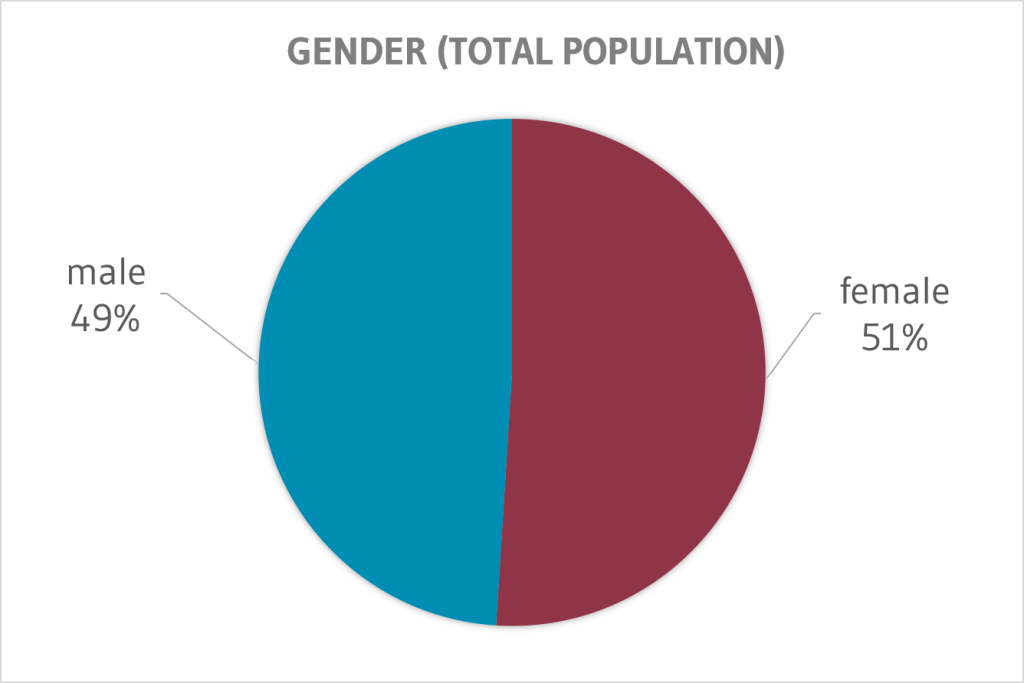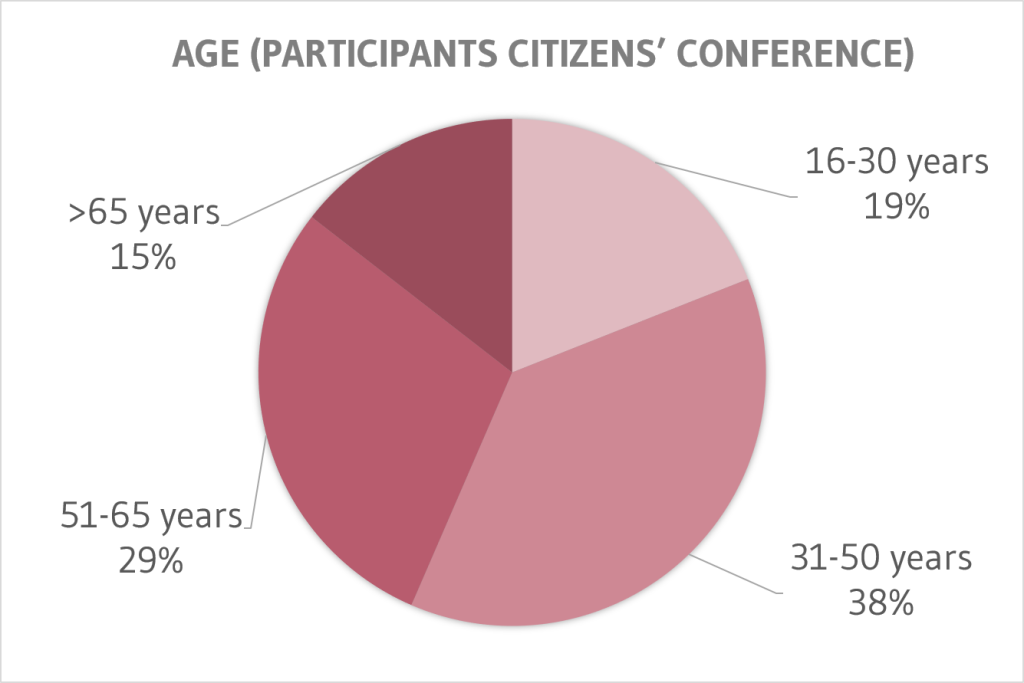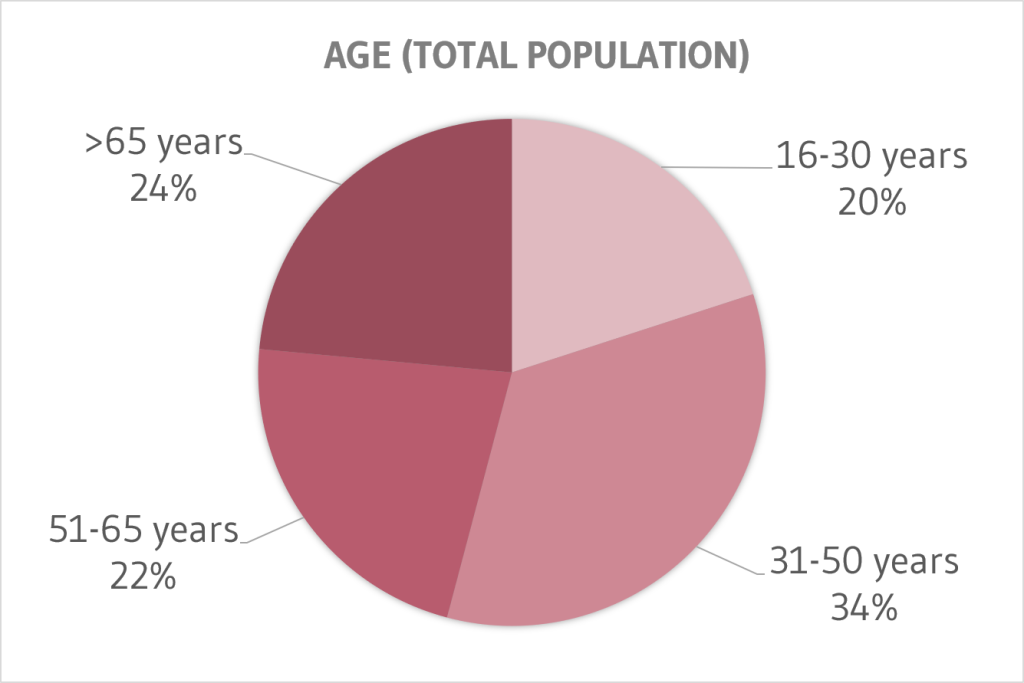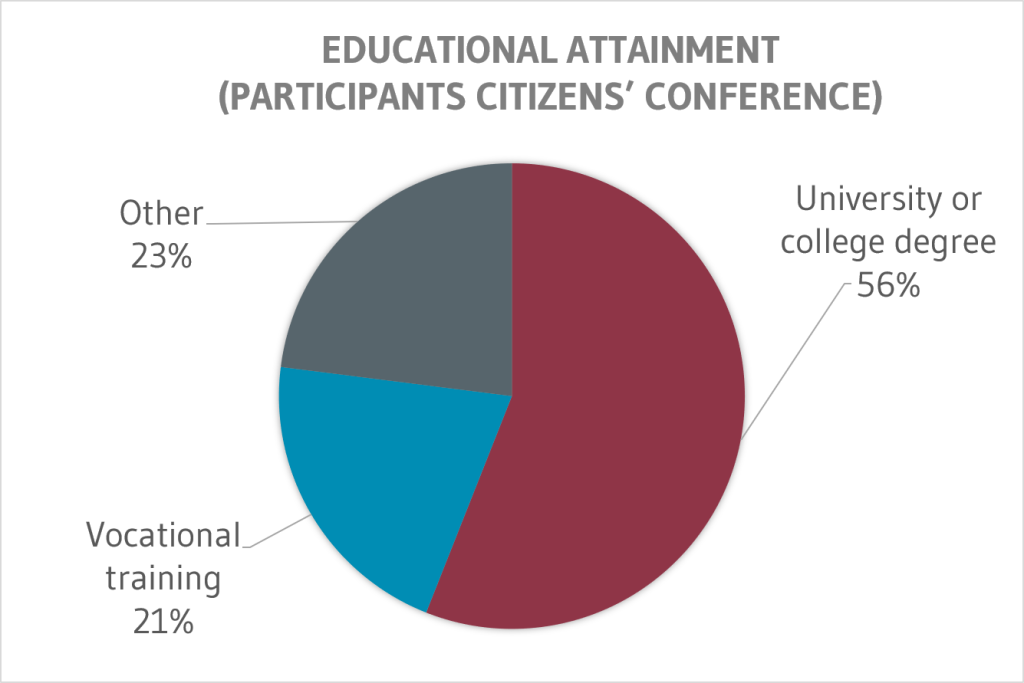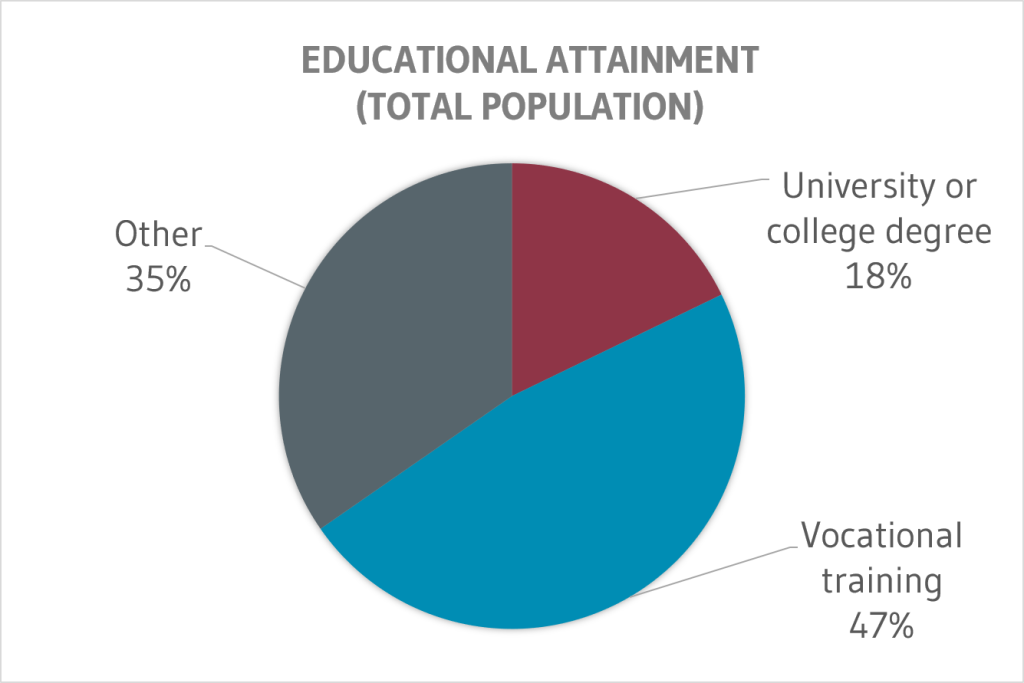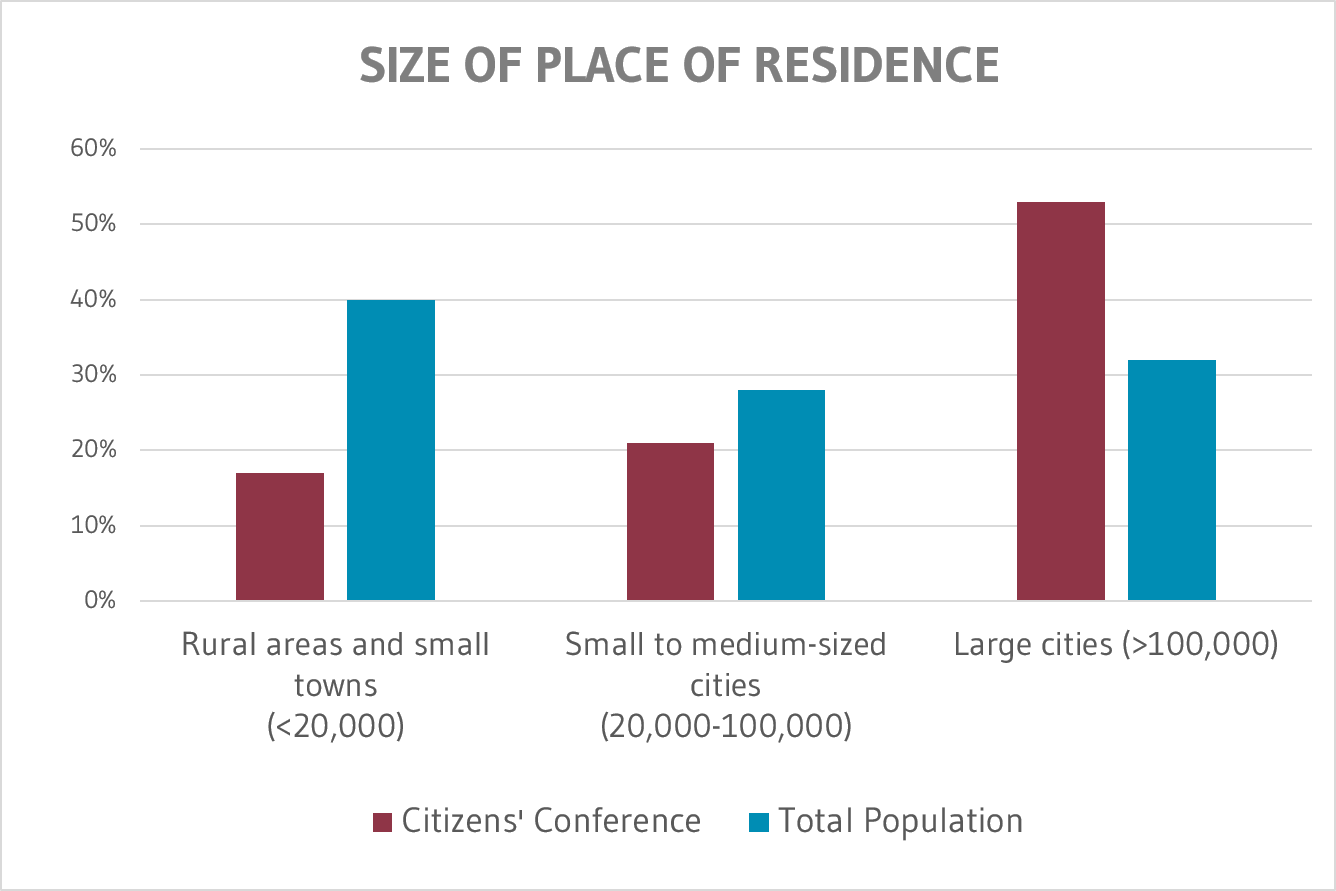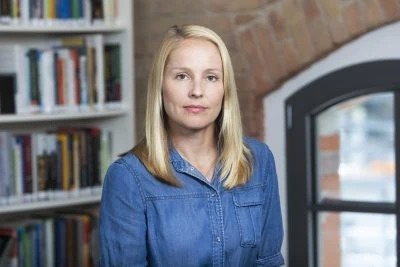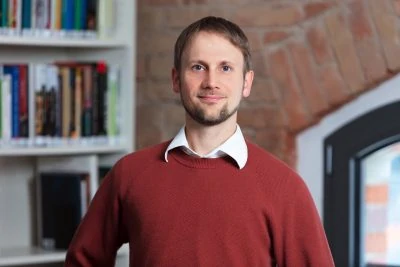Content
Summary
The Ariadne project is shaping a learning process between science, politics, business and civil society in order to provide a broad knowledge base for decisions on the energy transition. Since the beginning of the project, researchers have been working closely with randomly selected citizens on the topics of energy transition and transport transition. Two citizens’ conferences formed the core of this collaboration after one and a half years of project duration. Here, possible policy pathways for shaping sector transformation presented by researchers were discussed, evaluated and further developed by citizens. The conference on the electricity transition took place in Kassel in November 2021 and was attended by 48 randomly selected citizens and three researchers from the Ariadne project1The second citizens’ conference was held in Würzburg on November 13 and 14, 2022 on the transport transition. You can find the summary of the results here: https://ariadneprojekt.de/publikation/report-results-citizensconference-transporttransition/.
Values-based discussion provides new insights and sharpens scientific policy advice
At the conference, the citizens discussed issues according to the principle of deliberation. This describes the joint weighing of arguments and empirical knowledge in moderated (small) groups with the aim of achieving greater understanding within the group by discussing factual arguments and the values behind them. During implementation, successful deliberation is characterised by the fact that learning about social issues takes place in dialogue, different value concepts are respected and listened to, and discussions go beyond individual feelings, i.e. are oriented toward the common good. In the discussions at the citizens’ conference, central views and value criteria of the citizens became clear. The results serve as an important source of reflection for scientific policy advice and at the same time provide substantive supplements. The visualisation of value dimensions and controversially discussed sticking points aims to increase the quality of orientation knowledge for politics and to place decisions on a broader knowledge base, since a wide variety of social knowledge flows into the advisory process in addition to scientific knowledge.
Centralised and decentralised energy world as a basis for discussion
The discussion focused on two energy worlds which describe opposing, potential development pathways and are based on Ariadne research results. The central energy world is characterised by power generation with a lot of wind energy and some solar areas at particularly high-yield locations. This requires expansion of the transmission grid to bring the power to consumers. In contrast, the decentralised energy world describes an electricity system in which electricity is generated at many different locations with a high level of participation by citizens, for example as owners of small photovoltaic systems on rooftops or as members of energy cooperatives. But here, too, grid expansion is a relevant factor. In addition the citizens’ conference addressed superordinate challenges which play a greater or lesser role in both worlds: for example, plant expansion and species protection, land use planning for renewable energies, financial participation opportunities and the ownership structure. The goal of the citizens’ consultation was to gain a better understanding of their priorities and underlying values, but also to explore opportunities for trade-offs and compromise.
Citizens prefer a decentralised energy world and want fair distribution of opportunities and burdens
The evaluation is based on the synthesis of the discussions supplemented by the results of the accompanying research from a before and post-survey of the participants. Both the discussions over the two days and the end-of-conference survey showed that a large majority of citizens would rather have a decentralised world (96 % saw it as desirable, n=45), but also see advantages in the centralised world (47 % saw it as desirable, n=45). Participants value the potential of the centralised energy world for quick results with clear accountability, security of supply, and system-optimal expansion plans. They would like to combine this with the promise of more participation and ownership for citizens in the decentralised world and its potential for social innovation and social ownership in the energy transition. The municipalities are said to play an important role in the energy transition, which should be strengthened at least in the decentralised energy world by anchoring climate protection as a mandatory task. With regard to land availability and species protection, the participants prioritised the use of already built-up areas, so that, for example, the expansion of solar roofs or even wind turbines in industrial areas should be promoted. Regardless of their preference for the energy world, it was important to the citizens that opportunities be negotiated fairly and that burdens and benefits be distributed equitably. Self-determination also played an important role. The citizens were in favour of clear rules, but nevertheless freedom of choice should remain and desired behaviour should be promoted through incentives. The majority of participants emphasised that the deliberation at the citizens’ conferences has already contributed to a better understanding of the energy transition. Some participants saw themselves in the role of multipliers for this knowledge and expressed the intention to address and discuss these topics more in their circles of acquaintances.
1. Background and subject of citizen deliberation: Two energy worlds
Germany has set itself ambitious targets for the energy transition, which have been further specified by the new governing coalition. By 2030, the share of renewable energies in gross electricity consumption is to rise from the current 42 % to 80 %. This pressure to act is intensified by the fact that electricity demand will grow from around 560 TWh today to 680 to 750 TWh in 2030 as a result of sector coupling. That targets alone do not guarantee success is shown by the trends of the last two years, in which the addition of renewables lagged behind. In order to achieve targets, it is necessary to have a package of measures that is supported by society. That is why the Ariadne Kopernikus project is based on a joint learning process between science, politics, business and civil society. From the outset, citizens have also been involved through dialogue formats in order to integrate their perspectives into the research processes on policy options in the energy and transport transition.
The dialogue between society and science began in the fall of 2020 with regional online discussions throughout Germany, in which nearly 100 randomly selected citizens talked about the challenges of the energy transition and what is important to them in its implementation. The results were included in the Ariadne research and further deepened in co-creation workshops between science and citizens in spring 2021.

Source: Exploration module electricity
In the topic area of electricity transition, two energy worlds were then developed based on model calculations and qualitative studies by participating Ariadne research institutes (Fraunhofer IEE, Hertie School, TU Munich, TU Darmstadt) in order to make the contrasts of possible development pathways of the electricity system accessible to citizens. Both worlds and the underlying measures as well as accompanying challenges of energy system development were discussed at the citizens’ conference in November 2021. The energy worlds did not serve as blueprints for which participants were to decide, but as poles between which the possibility space of a future, sustainable energy world spans.
In both worlds, electricity is not only becoming “greener,” but increased electricity demand (see Figure 1) is assumed to result from sector coupling. However, the worlds differ in the structure of the energy system and set different priorities in the technology mix.
Centralised energy world

In the centralised energy world, large energy producers centrally ensure our power supply. Energy plants are expanded where yields are high. This requires more capacity in the transmission grid to bring the electricity from the generation sites to the consumers and large energy storage facilities. Electricity is increasingly being generated by large wind turbines: offshore and onshore, so some turbines are located in forests. There are also solar plants on roofs and open spaces.
Although the overall costs of the system are lower than in the decentralised world due to economies of scale and because wind turbines are cheaper than, for example, rooftop solar, the profits generated also accrue only to a few large companies. The participation of citizens in electricity production via rooftop solar installations and intelligently controlled self-consumption of electricity is rather low. Nevertheless, solar modules are installed on some roofs of private and public buildings. The power transmission grid is being expanded, especially by replacing existing power poles with taller poles with more lines by 2045, starting in 2030. In general, wind turbines will have to be built more quickly than previously planned. This will require increasing the current designated areas and annual tender volumes, reducing country-specific distance rules, and speeding up approval processes for new plants.
Decentralised energy world
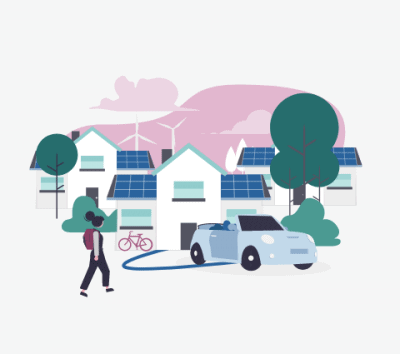
In the decentralised energy world, electricity is generated at many different locations. It moves closer to the everyday lives of many people and relies on a high level of social participation. Many people have small generation plants privately or, for example, as members of energy cooperatives. This leads to a world with more solar power and a somewhat smaller share of wind power. Solar panels are on almost all the roofs covering private and public buildings. In addition, solar arrays are located in fields, next to highways, and on other open spaces. Wind power is expanding in high-yield locations. The total cost is higher because rooftop solar is more expensive to the power system than wind. In return, self-consumption of solar power is being further strengthened, i.e. private individuals and companies are increasingly producing, consuming and distributing their own electricity, so that they also have their own benefit from the conversion of the power system. For this, there is intelligent control of electricity demand. For example, electric vehicles are preferably recharged when the electricity supply level is particularly high. Consequently, for the decentralised energy world to work, smarter power grids, flexible power consumers and distributed storage are needed. The “intelligent” control of electricity storage and feed-in takes place via digital applications in the “last mile” of the power grid, i.e., at the level of the distribution grid close to the consumer.
These digital applications must guarantee a high level of data protection, as they access consumption and production patterns to guarantee a stable supply for all. As more electricity is produced locally, the need for taller and more powerful power poles and power lines is somewhat reduced. Compared to the current grid infrastructure, however, both worlds require an expansion of transport capacity.
The expansion of solar energy takes place through a solar roof obligation and can be supported by subsidies such as interest-free loans. Because the sun alone is not enough to meet our electricity needs, wind farms must also be expanded. To this end, the distance rules for wind turbines must also be relaxed so that more land is available for this purpose. Overall, the available area for renewable energies must therefore be increased. However, it is not necessarily the case that forest areas in the decentralised world must be used by wind turbine farms.
Challenges in both energy worlds
Regardless of the shape of the energy world – more centralised or decentralised – there are a number of challenges that must be addressed if the transformation of the energy system is to succeed. These were also debated at the citizens’ conference. They include, for example, conflicts relating to environmental protection and species conservation or the impairment of the cultural landscape in the case of wind power projects. In addition, there are questions of the decision-making level for the restructuring of the energy system: while goals and priorities are usually set at higher political levels, concrete implementation takes place on the ground. Here, there are formal citizen participation procedures, but the scope for decision-making is limited. The exploration of equitable distribution in the energy system also addresses a number of issues: the geographic distribution of plants, ownership and actors in electricity production, financing models and the role of municipalities. Points of contention here are, for example, whether there should be as even a distribution of generation facilities as possible across all states or whether other criteria such as the level of consumption or site suitability should be guardrails. Furthermore, it is being discussed whether project developers of generation plants should pay a part of the profits or special levies to municipalities and how these are then used locally – via the public budget or as a distribution to each individual. In general, all of these issues are about questions of access and responsibility.
| Centralised world | Decentralised world | |||
|---|---|---|---|---|
| Current electricity generation (TWh) | 2030 | 2045 | 2030 | 2045 |
| Total: 488 | 673 | 976 | 688 | 1008 |
| Solar: 51 | 96 | 195 | 178 | 378 |
| Wind Offshore: 27 | 78 | 73 | 78 | 73 |
| Wind Onshore: 104 | 280 | 541 | 235 | 403 |
| Gas: 59 | 105 | 74 | 79 | 61 |
| Coal: 117 | – | – | – | – |
| Other: 129 | 118 | 93 | 118 | 93 |
| Of this, solar roofs | From 207 kW/km2 in Saxony-Anhalt to 2111 kW/km2 in Berlin in 2045 | From 354 kW/km2 in Brandenburg to 4603 kW/km2 in Berlin | ||
| Memory and flexibility | Less load shifting for e-vehicles and heat pumps More central heat storage in the district heating and industry sectors 2045 Home battery storage: 45 GWh District battery storage: 57 GWh Central heat storage: 687 GWh | More load shifting for e-vehicles and heat pumps Fewer central heat storage facilities in the district heating and industry sectors 2045 Home battery storage: 102 GWh District battery storage: 0.6 GWh Central heat storage: 270 GWh | ||
| Net | The transmission grid will be expanded to connect centralised generation structure with consumption centres (esp. north-south). Additional development of centralised storage capacity. Slightly lower need for digitisation at distribution grid and network consumer level. | Above all, the digitisation of power grids is being driven forward. In addition, distributed storage capacities are being built up. Slightly reduced need for transmission system expansion. | ||
| Costs | Cost increases for energy-intensive industry, cost relief for SMEs, businesses and households. | Cost increases for energy-intensive industry, cost relief for SMEs, businesses and households. | ||
| In general, the system is cheaper due to more wind power. On the other hand, this is offset by higher grid expansion costs. | In general, the system is more expensive due to more rooftop V and storage. On the other hand, decentralised flexibility can reduce the need for grid expansion and thus the costs for it. |
Source: Own representation
2. Method
2.1 Research question and method
At the citizens’ conference in Kassel, 48 randomly selected citizens discussed their personal experiences and assessments of the two energy worlds and the challenges at six tables. The conference alternated between information and discussion parts in the plenum with all participants and deliberation phase at the six tables. The discussion was supported by introductory presentations of the Ariadne researchers as well as by a digital application developed especially for the citizens’ conference, which illustrates the results of the Ariadne research3The application is available online here: https://ariadneprojekt.de/explorationsmodul-energiewende/. The question was asked: What advantages and disadvantages do you see for yourself personally and for society in each energy world? What is acceptable to you personally and to society? And what is not? Also discussed were upstream and downstream challenges which play a role in each of the two worlds, such as access to the energy transition, participation in decision-making, responsibility, and information. These topics were discussed across the tables, so not all tables discussed all topics, but there was only plenary feedback on them. Finally, it was to be considered whether and how the energy worlds could be combined and which aspects should be given special attention in each case from the point of view of the citizens. The most important results of the table deliberations were jointly recorded by each group with the help of moderation boards. A total of 25 moderation boards were created during the two days of deliberation, which were then written down and clustered.
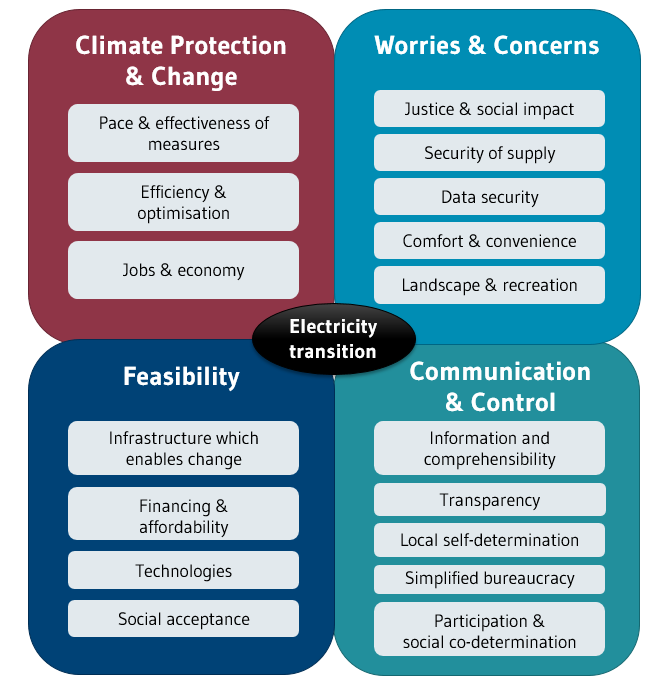
Source: Own representation.
This qualitative content analysis (after Mayring 2010) is based on the synthesis of the written moderation boards of the table discussions on the one hand, and on the results of the before- and after-questionnaires of the participants, which are part of the accompanying research, on the other hand. The analysis does not reflect an agreed majority opinion, as this is not the aim of the deliberation. Instead, it is about the representation of a variety of citizen perspectives in different focal points of discussion, some of which emerged from the exploration module, others from on-site interaction. The accompanying research examines the quality of the deliberation as well as the learning process of citizens and scientists. It also includes the reflection of values and changes in attitudes. The pre-survey was sent out online a few days before the conference, the post-survey was conducted in writing on site in Kassel. 35 participants took part in both surveys, on which the before and after comparisons are based. The focus was on the question of which ethical criteria and conditions citizens use to judge whether they find an expression in the respective energy worlds desirable or not (cf. Clarke 2003, Kopernikus Project Ariadne, 2021).
Four clusters of values emerged from the value criteria: Climate Protection and Change, Concerns and Concerns, Feasibility, and Communication and Governance (see Figure 1). These value criteria supported in the analysis of deliberation. At the same time, they provide information on which criteria citizens use to evaluate political measures. This is also relevant for the further research process as well as the communication of the research results.
The discussions at the citizens’ conference combined rationales from different clusters of values: Many were both in favour of change to protect the climate, but at the same time expressed concerns and worries about how that change would play out. Strikingly important in the evaluation of the worlds was the value of “participation and co-determination,” which the majority of participants see as more feasible in the decentralised world. Nevertheless, there are concerns, for example, about supply and data security in the decentralised world.
2.2 Method reflection with regard to the summary of results
In addition, three days after the conference a feedback survey was sent to the participants on the course of the conference, the results of which supported the evaluation of the content analysis. Although all participants evaluated the conference in the feedback survey (36 participants) predominantly positively, some points which should be considered in the reflection of the summary should be pointed out here:
- Participants were selected at random. Due to the increasing incidence of corona and the local 2G rules, some invited persons cancelled their participation. As a result, the target number of 65 participants and a representative number of participants for Germany according to selected criteria was not achieved. For example, participants with an immigrant background, those with a secondary school diploma or no diploma, and those from cities with fewer than 100,000 inhabitants were under-represented. This reduced the diversity of perspectives. Also, the exchange of content with interactive formats across the table groups could only be implemented to a very limited extent in order to comply with health protection and hygiene rules.
- The table moderations were praised by the majority of the participating citizens. Nevertheless, it was noted that the dual role as moderator as well as documentation of the discussion results on the moderation boards was sometimes overwhelming (“The moderator could not write down all the findings.” Participant feedback).
- Documentation: This also resulted in the second weak point of the content analysis: important sticking points of the table discussions were partly lost and some recorded key points on the moderation boards were not clear. (“The notes on the pin board leave too much room for interpretation. Furthermore, the insights gained in detail are lost due to the summaries” Participant feedback).
- Regarding the expansion of power lines, there was a misunderstanding between citizens and science. The energy world models are not clearly different with regard to the expansion of power grids. However, due to the model explanation that in a decentralised world, generation is more close to consumption, some participants assumed a lower expansion of power lines in the decentralised world, which is now also reflected in the results. This would have to be clarified in the further process, as would the other open questions (see chapter 3.5).
The following is a summary of the key findings from the citizens’ conference, which begins with an assessment overview of the two worlds as a synthesis of the discussion. Then, the citizens’ views on the challenges and conflicts are presented. Finally, the most important criteria for combining and further developing the energy worlds are explained and an outlook on the further course of the learning process is given.
3. Results of the deliberation
3.1 Key feedback on the worlds and challenges
Basically, the participants discussed both worlds very openly and saw advantages and disadvantages in each case, both for themselves personally and for the environment and society. Some participants found it “helpful” (feedback survey) to discuss along the two worlds as “future poles of an energy transition as a starting point”. Others felt “too limited in perspective” (survey feedback) with the focus on wind and solar. The personal and the societal view of the present citizens are summarised below, since many personal points were also mentioned on the societal level. However, the demand of the personal level was considered an important entry point to build up a bigger picture from there. In principle, the disadvantages of the worlds summarised here from the deliberation from the citizens’ point of view are not fundamental rejections of certain political measures or projects, because the goal of the deliberation is not acceptance inquiries, rather the weighing of options against the background of various value criteria. Rather, it is a matter of giving special attention to these in further science-based policy deliberation and, if necessary, of cushioning them with further measures.
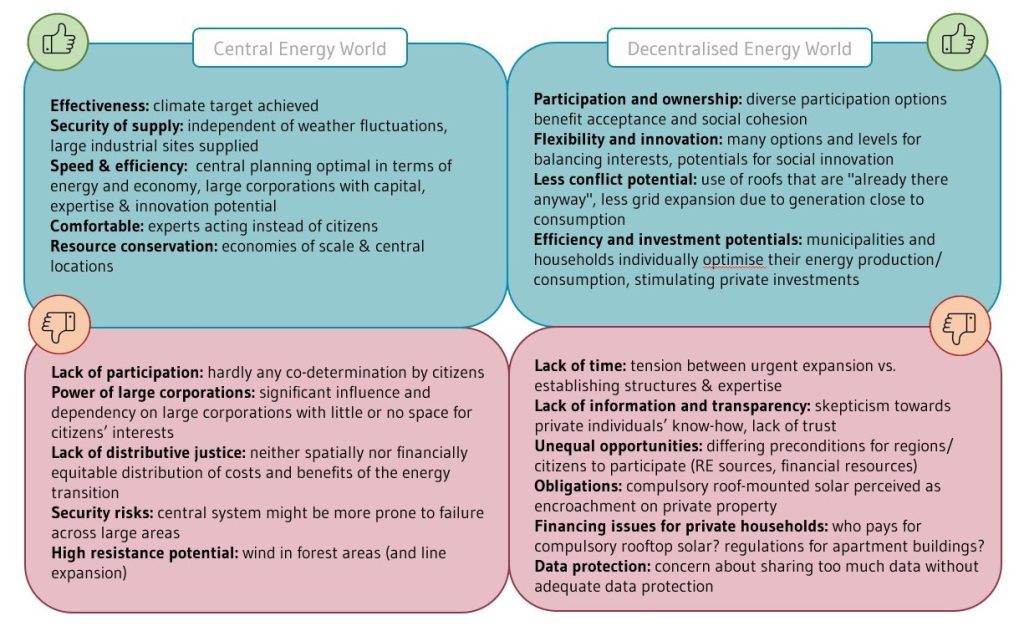
Source: Own illustration based on accompanying research and analysis of citizen’s conference
3.2 Centralised energy world
In their discussion, the participants attested advantages to the centralised energy world in the points:
Pre and Post-Survey:
In a direct comparison of the worlds, the central world was the favourite for only about one fifth of the participants (before: 22 %, after: 17 %). However, when asked individually (on a scale of -4 to +4), the average approval of the world after the deliberation rose slightly from a slight minus to a slight plus. It was noticeable that the proportion of clear opponents decreased. Before the conference, 19 % rated the central world as mostly undesirable (-3 %). After the conference, only 6 % did so. No one rated the world as “not at all desirable” (-4 %).
- Security of supply, efficiency and speed: The centralised world gave the participants a sense of security that the expansion of renewable energies can be implemented more quickly and in a system-optimised manner in terms of grid expansion and technology mix. Many see greater independence from weather fluctuations as positive. In central planning, high-yield sites could, in their view, be better integrated into the overall system and large-scale industry better supplied (“Don’t see any alternative for fast and large investments. The industry needs planning security.” Participant feedback). Innovations would be better realised in large companies, so that in general a faster implementability of a climate-friendly power system can be expected. Finally, they see the supply of cities and industrial locations with high consumption better secured in a centralised world.
- Convenience, comfort instead of far-reaching personal responsibility: The centralised world has the advantage that it is relatively convenient for citizens and still brings about change. The “electricity comes out of the socket” and experts take care of the optimal provision of climate-friendly energy with clear responsibilities (“Citizens don’t have to take care of anything. Technical expertise remains with the specialist companies.”).
- Resource conservation: The greater concentration of renewable energy (RE) plants can protect valuable areas and landscapes. In addition, economies of scale can make the expansion of RE plants, in operation, recycling, and grid expansion more resource-efficient.
However, the centralised world also met with considerable criticism:
- Lack of participation: The main criticism of the citizens present regarding the central world was the lack of opportunities for participation and co-determination on the one hand, and the continued considerable influence of large corporations in the implementation of the energy transition on the other (“Citizens are largely excluded, so that co-determination and participation are lacking.” Participant feedback). Many participants expressed concerns that large companies exert too much influence on political decisions through profit-seeking, monopoly positions and dependencies, for example in electricity pricing and the electricity mix, and that citizens’ interests are not reflected enough.
- Security and risks: Some citizens fear that a centralised system is more susceptible to counter-attacks and overloads on a large scale.
- Distributive justice: In the opinion of the citizens the costs and benefits of the energy transition are not distributed fairly, either spatially or financially, in a centralised world. Spatially, electricity is not generated where it is needed. Thus, transmission lines have to be expanded, usually at the expense of a minority: both in terms of private land and regional grid fees. According to the participants, this can lead to a lack of acceptance. In addition, profits primarily benefit large companies, which in turn influence policy in their favour, they worry.
- Resistance to wind in forest areas and line expansion: In order to ensure security of supply in the centralised system, more power lines tend to have to be expanded. Likewise, wind turbines in forest areas cannot be ruled out. In the opinion of the citizens, this is associated with a high potential for conflict, as forest areas are an important recreational area for many and protests against power lines have been frequent in the past.
3.3 Decentralised energy world
In the decentralised energy world, the majority of participants welcomed the following aspects:
- Participation and ownership: There was broad support for the diverse participation options in the decentralised world. This would promote personal responsibility and social cohesion. In addition, it was frequently mentioned that smart meters would increase awareness of one’s own energy consumption and thus generate greater identification with the energy transition and acceptance for energy transition projects.
- Flexibility, connectivity and innovation: In the view of the participants, the open character of the system could better balance the interests, ideas and financial resources at the various levels: be it at the budget, local, municipal or district level. In a decentralised energy world, co-design and creativity would thus be stimulated and social innovation potentials would come to fruition. If decisions were made at smaller levels, things could also be tried out more easily. This, in turn, would enable a better understanding of the energy transition with its opportunities and challenges. Specifically, gamification approaches or competitions were also mentioned as incentive formats which would be made possible thanks to the openness of the decentralised energy world. It was also suggested that elements of the centralised world could be integrated into the decentralised energy world.
- Avoiding land and grid expansion conflicts: “The utilisation of rooftops was considered a sensible approach. Since rooftops are “there anyway,” less new land would have to be taken up for the expansion of renewables. Providing power close to consumption would also reduce the requirement for new transmission lines, ultimately lowering the potential for conflicts in the process.”
- Efficiency and investment potentials at the municipal and household level: According to the participants, a more decentralised energy transition holds new potentials for the municipal level as a business location, but also as a place of cooperation and efficient local control. Citizens themselves could optimise their household consumption and invest their money sensibly and save electricity costs through financial participation opportunities or as prosumers4The term “prosumer” is derived from the combination of the words “producer” and “consumer” and, in the context of the energy transition, refers to energy consumers, i.e. consumers who simultaneously produce energy and thus at least partially supply themselves. These are often owners of private photovoltaic systems on their own homes. – for example, as owners of their own solar power systems.
- Costs: Generation close to consumption results in fewer transport costs for electricity. Furthermore, the participants assumed that in a decentralised electricity system, prices are more likely to be socially just, since they do not depend on large companies alone. In addition, consumers can save money through flexible electricity tariffs.
- Risks: Due to the decentralised, rather small-scale arrangement, the citizens estimate the risk of large-scale disturbances as low.
- Animal welfare: By using already sealed areas and fewer wind turbines, the participants see animals better protected in the decentralised energy world.
In addition to the positive aspects, challenges and criticisms that would be brought forth in a more decentralised energy world were also mentioned in the deliberation:
- Unequal opportunities and distributional issues: Participants fear that not all citizens would benefit equally from a decentralised energy world. Distributional issues arise between RE-rich and financially strong regions versus RE-poor and financially weak regions, between poor and rich citizens as well as homeowners and tenants or even “digital natives” and older generations.
- Unequal access to information and personal responsibility: In a decentralised world, information is also unequally distributed with a high degree of personal responsibility. The electricity market and important “players” are not very transparent for the majority of citizens, so that there is a certain scepticism as to whether private individuals can really become energy producers to a sufficient extent or whether experts are not needed. In addition, in the decentralised energy world, one would have to rely on others. Particularly in view of information imbalances and the complexity of the electricity market, this is not easy and harbours potential for conflict. Against this background, a decentralised energy world is difficult to control. The citizens fear that there are too many participants with too few control options; many locations, including infrastructure, must be available and fit together. The balancing of generation and consumption was seen as potentially problematic.
- Reducing bureaucracy: The citizens were sceptical that the current complex bureaucratic procedures would enable administrations to support decentralised expansion efficiently, effectively and in a way that is close to the people. Transparency in the construction of new facilities and simplified access to funding opportunities are therefore seen as important.
- Time: Closely related to this is the urgency of the challenge. A decentralised system requires new structures and knowledge. Both must first be built up in a targeted manner. At the same time, the expansion of renewables is pressing.
- Ownership and freedom versus obligation: A solar roof obligation was seen by some as a major encroachment on freedom and ownership. The requirements to flexibly adjust electricity consumption were also seen as challenging. The right of final decision on this should in any case lie with each individual. In general, the participants felt that there was a great need for behavioural change and education.
- Financing and affordability: Participants expressed doubts about whether and how a decentralised world can be financed, as installations and structures are more distributed between different actors. For example, who would have to pay in the case of a solar roof obligation? This is not clear for both single-family and multi-family homes, they said, and difficult to implement for the latter. They suspect high initial investment costs, which private households with low incomes would generally not be able to afford as well as large energy companies.
- Environment and resources: Due to the large number of renewable energy plants and higher technical redundancy, the decentralised energy world is less efficient in economic terms and more resources are consumed. The participants assessed this as negative.
- Data protection: In a decentralised energy world, citizens will be more involved in the control and supply of the energy system as prosumers and via smart meters. This requires the exchange of data with citizens as well. The participants understand this necessity, but were in favour of data being requested and used only to a reasonable extent and for a specific purpose, at best anonymously; misuse should be prevented.

(before-after comparison, n = 36) Source: Own representation

(“forced-choice“, before-after comparison, n = 36) Source: Own representation
3.4 Pre and post-survey
BEFORE-AFTER SURVEY:
In a direct comparison, the decentralised world was the clear favourite among most citizens (before 78 %, after: 83 %). Likewise, the average approval was significantly higher (by about 2 percentage points). The survey found that the decentralised world was perceived as significantly fairer in comparison, which was reinforced by the conference.
In the separate pre and post-survey on both energy worlds, it is clear that the decentralised world was rated as desirable by the vast majority (n=36). The centralised world is also rated as desirable by more than half of the participants.
A direct comparison (“forced choice”) shows that approval of the decentralised world increased by 5 percentage points after deliberation, while the centralised world lost 5 percentage points. More than two-thirds of respondents in this survey favoured a combination of the two worlds (see chapter 4).
3.5 Open questions for further assessment
For a more in-depth assessment of which characteristics of the electricity system are desirable for the citizens, some questions remained unanswered:
- Weather effects: Are weather effects of climate change included in the scenarios, such as storms, cloud formation, global warming?
- Costs: Which energy world is more expensive for the individual consumer?
- Data security and vulnerability: Which system is more susceptible to hacking? Is it true that the decentralised system is more likely to experience local failures, but not large-scale problems?
- Other renewable sources and technologies: Do other renewables such as hydro-power still play a role in the scenarios?
- Life cycle: What is the life cycle of wind and solar power plants?
Due to the fact that the decentralised energy world has hardly ever been experienced so far for many citizens and is therefore little imaginable and associated with more responsibility, it is not surprising that further questions were raised in this regard:
- V areas: Are areas of existing and planned buildings sufficient for expansion of solar installations?
- Who bears responsibility for security of supply in a decentralised world?
- How is the risk management in case of natural disasters carried out against the background that in a decentralised energy world many RE plants are in the hands of citizens? What happens, for example, if V systems are defective due to a natural disaster and cannot be used for a long time or an expensive repair is necessary?
3.6 Citizens’ views of the challenges
3.6.1 Information and participation
Regardless of the type of energy world, the participants also discussed upstream and downstream challenges that need to be addressed in both worlds. Depending on the choice of energy world, different approaches to solutions exist. These included the resolution of conflicts in the expansion of renewable energy plants, opportunities for participation, and distributive justice. In the following, hints, ideas and suggestions are presented, which emerged in the discussions on the conflicts and challenges.
With regard to energy transition conflicts, the participants saw opportunities in the provision of information and participation opportunities for citizens.
- Institutionalised information platform: There must be central points of contact where citizens can easily find out about their options for participating in the energy transition.
- Knowledge communication: It is important to choose a language and format that is appropriate for the recipient. In the view of the citizens, science also plays an important role here as a trustworthy actor. It must support the transfer of complex content to society and make transformation tangible, for example through additional digital apps that strengthen the sense of personal responsibility and suggest possible courses of action. Often, citizens feel a kind of powerlessness in the face of the flood of different information and few clear access channels. Likewise, science and communication were asked to present conflicting goals as objectively as possible in simple facts and figures and to convey them to citizens in such a way that the information content remains comprehensible. Over-information could also lead to disinterest. One question here concerned the speed of expansion: the participants were not sure which world could be implemented more quickly or would be safer from hacker attacks. Also with regard to species protection and the expansion of RE plants, the citizens reported perceived conflicting goals, which they could not objectively weigh against each other on the basis of facts. Furthermore, instead of only desirable futures, dystopia should also be made visible: What will happen if we do not act?
- Making the energy transition tangible: The citizens suggested an energy transition area where the transformation can be experienced like in an adventure park, or even pilot plants on a trial basis before an entire wind farm is built nearby.
- Participation versus time pressure to act: In general, the citizens would like to have more say within the municipality in the choice between solar or wind plants as well as co-determination of the location. The mediation of conflicts should be transparent and joint solution options should be developed. At the same time, the tension between rapid expansion and participation processes must not be exhausted: what is to be decided and when must be communicated early, comprehensibly and clearly defined.
3.6.2 Distributive justice
With regard to the question of spatial distribution justice, a rather fundamental opinion among the participants was that a “level playing field” between federal states, municipalities and citizens should be created, but that there should also be room for decision-making.
- Act more equitably on a federal level: To this end, there should be more central federal guidelines and less federalist solo efforts, for example, with regard to the distance requirements of wind turbines or the provision of land. No federal state should be allowed to shirk responsibility. However, the depth of the central requirements was disputed. On the one hand, municipalities themselves know best which areas should be used and how. On the other hand, far-reaching regulations can always mean an encroachment on personal freedoms. A concrete example is a solar roof obligation if it applies to all homeowners.
- Compensation of burdens: There was a consensus that compromises, compensation and financial offers should be made with local citizens in order to reduce conflicts and activate social potential. To this end, investors and project developers must familiarise themselves with the municipal structures. Together with local administrations and citizens, they should incorporate local interests and needs into planning processes, such as the desire for compensatory quiet zones and cultural landscapes. In the eyes of the citizens, areas which are already built-up should be used for RE plants as a priority. Wind turbines could preferably be located in industrial areas.
- With regard to the distribution of RE plants across Germany, there was no preferred logic: it should rather be a mixed form of high-yield and high-consumption.
In addition to spatial distribution, the focus was also on financial participation and financial distributive justice. Questions such as, “Who should own the RE plants? How should profits from RE plants be distributed?” were central to the discussion.
- Climate protection as an obligatory municipal task: In principle, the participants saw the municipal administrations as having a great responsibility to regulate and support the electricity transition locally. At the same time, the participants expressed scepticism as to whether the municipalities could currently bear this responsibility (organisationally, financially, communicatively). It was discussed whether climate protection as a mandatory municipal task could lead to better framework conditions and organisation. Transparency in the allocation and use of funds was very important to the participants, and a need for training in the above-mentioned points was seen among the municipalities.
- Fair distribution of profits: There was disagreement among participants as to whether profit shares from local RE systems should be paid to the entire community or only to those who have “bought in” through financial shares, for example.
- The communal pooling of profits was seen as the most socially acceptable option, since all citizens of a municipality would benefit from it, even if they were unable to participate financially in the plant. However, there was then a wish that the use of the municipal budget funds collected through profit sharing should be decided jointly with the citizens.
- The participants saw great potential in the individual distribution of the profits to all residents of the community to strengthen local acceptance and also to involve those who have not yet participated. The latter, however, was controversial in the discussion. In addition, profits should also be distributed to children and young people, since families shoulder the greatest burdens.
- Finally, the cooperative communitisation of profits was considered, which has the advantage that the members of the cooperative decide jointly what the profits are used for. Participants found this to be both market-based and democratic. However, this approach excludes non-members in the decision-making process and would negatively affect those who are behind the energy transition but cannot buy shares due to their financial circumstances. This could be offset to a certain extent by the municipality itself becoming a cooperative member.
- Local electricity tariffs: Another way to involve citizens more actively in the energy transition would be to offer local citizen electricity tariffs based on the expansion of renewable energies for residents within a certain radius. This approach, which is already being implemented in some regions, was welcomed by the participants.
4. Possible combinations and extensions
4.1 Citizen criteria from the discussion
As a final step of the deliberation, it was discussed whether, if so, and how the worlds should be combined in order to integrate positive aspects of both options into future planning processes from the participants’ point of view. In principle, the participants were in favour of a combination of the solutions presented. Values that were particularly important to them were speed of expansion as a value of the centralised world and co-determination and participation as values of the decentralised energy world. From the point of view of the citizens, however, the decentralised world is to a certain extent preconditional and requires a continuous development of structures and capacities, which should be initiated as quickly as possible: Information, knowledge and regulatory capacities as well as smart technologies must be built and expanded. The centralised world is easier and more efficient to control and therefore delivers faster results and a feeling of security. The citizens also advocated the development of further CO2-free forms of energy.
For a combination of both worlds, the following aspects should be considered from the citizen’s point of view:
Expansion logic:
- Close to consumption: As much energy as possible should be produced where it is needed in order to keep grid expansion to a minimum.
- Wind power: Areas already built-up such as industrial estates should be used in a concentrated manner. Smaller wind turbines, including vertical wind turbines, should be built next to V. Large wind turbines should also be located in good locations.
- Photovoltaics: solar obligation on public buildings. Solar panels on facades are conceivable. Parking lots, bike pathways and possibly streets should be covered with solar panels. This would not use up any more space and would have positive side effects such as sun protection, dryness in the rain and for parking spaces in combination with charging stations.
Control and responsibility:
- Participation: There should be guaranteed participation opportunities for citizens, and there should be easy-to-understand and easy-to-access financial return opportunities for many people.
- Municipalities: Municipal cooperative models must be strengthened. Climate protection should become a mandatory municipal task.
- Simplify approval procedures: especially for V expansion on roofs and grid connection. There needs to be clear points of contact and advice. A frequently recurring statement was that there must be more one-stop consultations and fewer bureaucratic hurdles to make it easier for citizens to get involved.
- Solar roof obligation: Should there be a solar roof obligation, then:
- …there should be a legal regulation of liability when leasing a V system versus own use,
- …should be clear whether roof leases can be handed over to service providers,
- …in the case of an obligation to use private roofs, the social and financial status must be taken into account and financial support for the initial investment must be possible.
- There should also be incentives for other services. The provision of land for storage and lines, for example, is a contribution to the electricity transition on private property.
- Infrastructures must be created to absorb the high level of personal responsibility for operation, maintenance and disposal of private facilities. Otherwise, citizens could be overwhelmed.
Information and education are important for both, but especially for decentralised approaches:
- A public, low-threshold information system (individual, local, national) as a digital display can provide citizens with important knowledge. Where are we (me, city, country) in energy production per energy source and sector? Targets and milestones could be visualised as well as benefits. This is about transparency and trustworthy sources. Science can be an important player here. More concrete information and incentives are needed to save electricity.
- Best practice exchanges between municipalities and citizens can make the opportunities and challenges of the energy transition easier to understand. These include citizens’ conferences that convey different perspectives on upcoming challenges and thus facilitate communication processes. But low-threshold approaches are also part of this, such as an open day for homeowners who have renovated their homes to make them more energy-efficient and who use renewable energy generation systems.
Electricity prices/flexibilisation:
- Those present could well imagine flexible electricity tariffs, but spoke out against absolute energy self-determination. Consumers should retain control and manage the control of their appliances themselves.
- E-cars should be able to be used as electricity storage units, also for feeding electricity back into the grid. However, it was important to the majority of those present that they have a sufficiently charged car available in the morning for their commute to work and other errands.
Digitisation/data security:
- Data protection: Data security was very important to all participants. For this reason, data for controlling the power system should continue to be collected as anonymously as possible in the future. There were also many fears of data theft and misuse. However, the participants accepted that data provision is necessary in a decentralised world and that this also entails a certain risk. However, this should be kept as low as possible.
- Expertise: The citizens warned that in a decentralised world, every citizen must have a certain amount of digitisation know-how at his or her disposal, whereas in a centralised world, this can be left to companies and politics. An education offensive is needed here.
Conflicts:
- Some participants argued that climate protection should take precedence over species protection. Others emphasised that wind power endangers species protection. Basically, a clear preparation and provision of data and facts was desired.
New ideas:
- In the context of the combination of both worlds (first centralised world, then decentralised world), a dismantling option for large wind turbines, for example, was proposed by some citizens. It should also be possible to dismantle plants if alternatives are available. This would leave some openness in the longer-term future for technologies, which could further promote acceptance.
4.2 Overview post-survey world combination
The results of the discussion on the combination and integration of the energy worlds are also reflected in the survey at the end of the conference. Almost two thirds of the citizens surveyed were in favour of combining the two energy worlds. Three superordinate proposals emerged:
- The combination of both worlds and their respective strengths: participation (decentralised world) and security and high speed of expansion (centralised world);
- The integration of the centralised world and its focus on wind power into the decentralised world, which should prevail for reasons of more participation opportunities;
- Some citizens proposed a strategy of prioritizing over time: First, the central structures should be expanded quickly, but in the long term, the decentralised world should enable participation.

Source: Post-survey of participants in Kassel (n=45)
Ideas on how the world combination could be developed further were also put forward in the survey:
- Some respondents wanted other renewable energy sources to be presented. The pure focus on wind and sun was sometimes unsettling.
- The role of electricity conservation within the population was also not given enough attention in the context of the worlds.
- It was also important for the participants to communicate about raw materials and the CO2 footprint of RE plants as well as e-cars in order to get an overall understanding of the energy transition.
- There should not only be financial participation in the energy transition, but also the possibility for citizens to participate in the further development of technologies and concepts.
- The role of bridging technologies in the context of the Citizens’ Conference was not addressed enough.
5. Evaluation and outlook
The aim of the conference was to convey to the participants the complexity of the different forms of the electricity system and future challenges, and to encourage them through the app and the deliberation to exchange their opinions intensively and to listen to other points of view. This goal was achieved. There were very interested and engaged dynamics at the citizens’ conference. Citizens discussed advantages and disadvantages of the worlds for themselves personally and for society and asked critical questions of science. Different realities of life, such as urban and rural, young and old, and different experiences in everyday work and family life, came together in the discussions and led to lively debates. Both the participants and the scientists present reported that they had gained new impressions and insights from the conference. Some of the participants decided to address the topics as multipliers in their circle of acquaintances and to create more awareness for the challenges of the energy transition. The question also arose in what form such citizens’ conferences could be conducted as an educational tool by a broader mass of the population.
Despite the different backgrounds and origins, there was a consensual tendency among the participants to prefer the decentralised world, as it provides more opportunities to participate in the energy transition as a citizen. Nevertheless, the participants appreciated the potential of the centralised energy world to ensure quick results with clear responsibilities, security of supply and system-optimal expansion plans. Since a more decentralised world entails a need for new competencies and structures on the part of citizen participation, the expansion of a more centralised world should first be pursued, but the structures of the decentralised world should be built up in parallel.
Some discussion threads developed a certain momentum of their own in the deliberation: how high the electricity prices would become for the individual consumer and how strongly the expansion of the electricity grids would have to be driven forward was not backed up with figures in the app. Nevertheless, the participants made assumptions about this based on the assessment of the premises of the energy worlds. Decentralised generation expansion was more strongly linked to variable-price electricity purchases and the potential to reduce electricity costs at the individual household level because of its closer proximity to consumers. In addition, there are questions about the design of distributional issues that are complex and could, in principle, be addressed fairly by different policy instruments in both worlds.
The municipalities are said to play an important role in the energy transition, which should be strengthened by anchoring climate protection as a mandatory task. With regard to land availability and species protection, the participants prioritised the use of already built-up areas, so that, for example, the expansion of solar roofs or even wind turbines in industrial areas should be promoted. Regardless of their preference for the energy world, it was important to the citizens that opportunities be negotiated fairly and that burdens and benefits be distributed equitably. Self-determination also played an important role. The citizens were in favour of clear rules, but nevertheless freedom of choice should remain and desired behaviour should be promoted through incentives. Finally, science needs to be a trustworthy actor, to bring complex content to society and to make transformation tangible through apps and through discussions in best-practice exchanges and citizens’ conferences.
Based on the feedback of the citizens, the Ariadne researchers will reflect and further develop their own assumptions and models. The second goal, to provide input to the scientific community, has thus also been achieved. In order to complement the policy advice of science with further perspectives, these results will be discussed with stakeholders from politics, business and organised civil society. This will be incorporated into the citizens’ summit to be held at the beginning of 2023, at which citizens will once again deliberate on selected concrete issues of the electricity worlds, present their findings and stakeholders will comment directly on them.
Appendix
Appendix 1: Event schedule
Appendix 2: Random selection and composition of participants
Our special thanks for the excellent cooperation and professional implementation go to the team at ifok; especially to Julia Hoffmann/Karoline Karohs. Ifok organised the random selection, implementation and moderation of the citizens’ conferences. We would also like to thank Dr. Arwen Colell and Dr. Cornelia Auer for the conception of the app, the Ramboll agency for the technical implementation; as well as Dr. Norman Gerhardt and Dr. Lukas Nacken for their scientific support and answering the queries at the conference in Kassel. Finally, we would like to sincerely thank all participating citizens for their time and openness and the many lively discussions and valuable feedback.
This Ariadne report was prepared by the above-mentioned authors of the Ariadne consortium. It does not necessarily reflect the opinion of the entire Ariadne consortium or the funding agency. The content of the Ariadne publications is produced in the project independently of the Federal Ministry of Education and Research.
References
Ariadne Explorationsmodul Stromwende (2022); https://ariadneprojekt.de/explorationsmodul-energiewende/
Ariadne-Website 2022: Bürgerdeliberation, https://ariadneprojekt.de/buergerdeliberation, Stand: 24.02.2022.
Clarke, A. (2003). Situational Analysis: Grounded Theory Mapping After the Postmodern Turn. Society for the Study of Symbolic Interaction, 26:4 (p. 553-576)
Blum, M., Colell, A., Hoffmann, J., Karohs, K., Kowarsch, M., Krude, M., Saur, M., Thiel, H. , 2021: Was ist uns wichtig bei Verkehrs- und Stromwende? Bürgerinnen und Bürger sprechen über Herausforderungen und Ziele. Kopernikus-Projekt Ariadne, Potsdam. https://ariadneprojekt.de/publikation/ariadne-report-fokusgruppen-verkehrswende_stromwende
Mayring P. (2010) Qualitative Inhaltsanalyse. In: Mey G., Mruck K. (eds) Handbuch Qualitative Forschung in der Psychologie. VS Verlag für Sozialwissenschaften. https://doi.org/10.1007/978-3-531-92052-8_42



